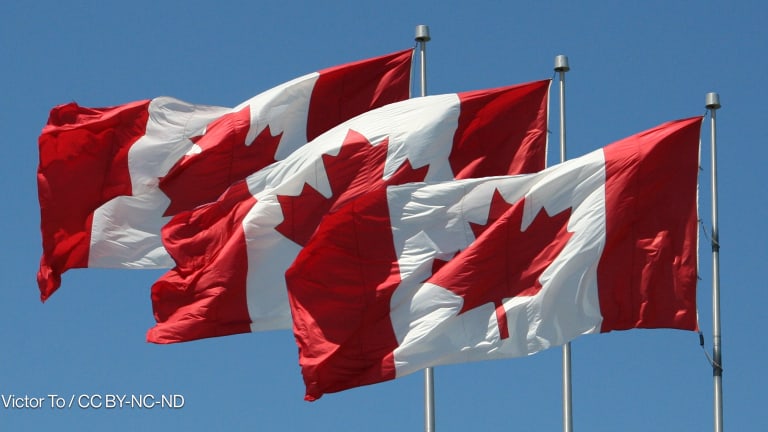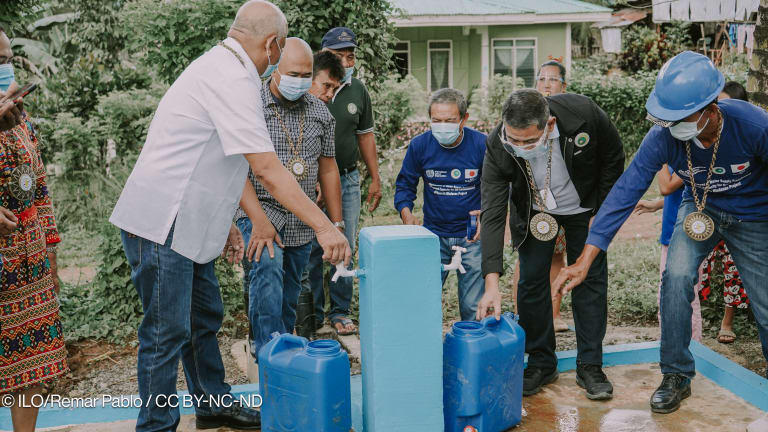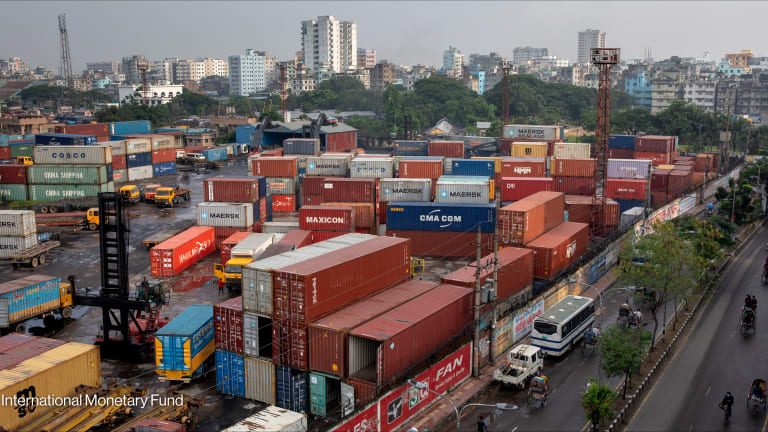How much aid actually reaches low- and middle-income countries?
Of the $178.4 billion bilateral aid in 2023, $76.9 billion was disbursed as country programmable aid — the portion of bilateral aid that recipients have a substantial say over.
Not all official development assistance is created equal. Part of it, called core multilateral aid, goes through institutions, such as the United Nations and the World Bank. Everything else is bilateral aid — from earmarked funding for social and economic projects, administrative costs, to debt relief. However, only a portion of bilateral aid is actually spent in line with the needs of people in low- and middle-income countries. That is called country programmable aid, or CPA. The Organisation for Economic Co-operation and Development introduced CPA in 2007 as a new method of estimating exactly how much ODA flows into the recipient countries. For expenditure to count as CPA, the OECD says that recipient countries must have a “substantial say” over how it is used. CPA therefore excludes forms of bilateral aid that are unpredictable in nature and that the recipients don’t manage themselves, such as humanitarian aid and in-donor refugee costs. Based on OECD, CPA was worth $76.9 billion in 2023 — about 43.1% of the Development Assistance Committee member countries’ $178.4 billion total bilateral aid that year. In this analysis, we looked into how the DAC member countries spent on CPA, who among the recipients received the largest sum, and which sectors were prioritized. All figures are in 2023 constant prices. What does the overall figure say? Although 18 DAC member countries upped their CPA by $4.9 billion in 2023, they were unable to offset the substantial $7.5 billion reduction among the remaining 14 members. Overall, CPA went down by 3.3% in 2023 — from $79.5 billion in 2022 to $76.9 billion. The bulk of CPA in 2023 went to project-type interventions, worth $62.9 billion, or 81.8% of the total. The remaining expenditures were: core contributions and pooled programs and funds, worth $6.3 billion; budget support, worth $5.2 billion; and experts and other technical assistance, worth $2.5 billion. How did the DAC spend on CPA? Our findings show that eight DAC donors spent at least half of their total bilateral aid on CPA, suggesting that the larger portion of their bilateral aid actually reaches the recipients. Among them, Japan disbursed the largest, worth $15.9 billion. This accounted for 77.8% of Japan’s total bilateral aid in 2023, worth $20.4 billion. South Korea ranked next, with $2 billion, or about 76% of its total bilateral aid, followed by New Zealand, with $439.7 million, or 68.7% of its bilateral aid. In monetary terms, the U.S. spent the largest CPA among DAC, worth $25.8 billion. Although this represented more than a third of the DAC member countries’ total CPA in 2023, the amount accounted for just 43.1% of the U.S.’s total bilateral aid. The remaining 24 DAC member countries spent less than 50% of their bilateral aid on CPA. Four among them spent less than 10% of their total: the Czech Republic, with $45 million, or 9.1% of its bilateral aid; Ireland, with $167.3 million, or 7.8%; Poland, with $94 million, or 5.5%; and Greece, with $116,588, or 0.2% of its total bilateral aid. <div class='tableauPlaceholder' id='viz1761554830553' style='position: relative'><noscript><a href='#'><img alt='Dashboard 1 ' src='https://public.tableau.com/static/images/DA/DACmembercountriesCPAin2023/Dashboard1/1_rss.png' style='border: none' /></a></noscript><object class='tableauViz' style='display:none;'><param name='host_url' value='https%3A%2F%2Fpublic.tableau.com%2F' /> <param name='embed_code_version' value='3' /> <param name='site_root' value='' /><param name='name' value='DACmembercountriesCPAin2023/Dashboard1' /><param name='tabs' value='no' /><param name='toolbar' value='yes' /><param name='static_image' value='https://public.tableau.com/static/images/DA/DACmembercountriesCPAin2023/Dashboard1/1.png' /> <param name='animate_transition' value='yes' /><param name='display_static_image' value='yes' /><param name='display_spinner' value='yes' /><param name='display_overlay' value='yes' /><param name='display_count' value='yes' /><param name='language' value='en-US' /><param name='filter' value='publish=yes' /><param name='device' value='desktop' /><param name='showShareOptions' value='false' /></object></div> <script type='text/javascript'> var divElement = document.getElementById('viz1761554830553'); var vizElement = divElement.getElementsByTagName('object')[0]; if ( divElement.offsetWidth > 800 ) { vizElement.style.width='100%';vizElement.style.height=(divElement.offsetWidth*0.75)+'px';} else if ( divElement.offsetWidth > 500 ) { vizElement.style.width='100%';vizElement.style.height=(divElement.offsetWidth*0.75)+'px';} else { vizElement.style.width='100%';vizElement.style.height='727px';} var scriptElement = document.createElement('script'); scriptElement.src = 'https://public.tableau.com/javascripts/api/viz_v1.js'; vizElement.parentNode.insertBefore(scriptElement, vizElement); </script> <i style=font-style: georgia;”>DAC member countries’ CPA spending in 2023, based on OECD.</i> Who got the most CPA among the recipients? Small island developing states, or SIDS, and non-self-governing territories appear to have a higher bilateral ODA-to-CPA ratio among recipients. We found four that received their entire bilateral ODA as CPA: • Saint Helena, worth $17.6 million • Montserrat, worth $10.7 million • Tokelau, worth $15 million • Wallis and Futuna, worth $160.5 million In cash terms, Ukraine was the largest recipient of CPA, with $13.1 billion, or 17% of the total. Around 81.4% of that amount, worth $10.7 billion, came from the U.S. Ukraine’s other top donors included Germany, with $751.7 million, Norway, with $536 million, and the Netherlands, with $268.3 million. India, which was the overall top recipient of CPA in cash terms between 2017 and 2021, ranked next, with $5 billion, or 6.6% of the total. Japan was India’s top donor, with $3.8 billion, or 74.6% of India’s total CPA. Other top donors were Germany, with $706.7 million, France, with $176.5 million, and the U.S., with $167.9 million. Other top recipients of CPA included Bangladesh, with $2.9 billion, Indonesia, with $2.3 billion, and the Philippines, with $2 billion. <div class='tableauPlaceholder' id='viz1761554569070' style='position: relative'><noscript><a href='#'><img alt='Dashboard 1 ' src='https://public.tableau.com/static/images/RR/RRS36FWF2/1_rss.png' style='border: none' /></a></noscript><object class='tableauViz' style='display:none;'><param name='host_url' value='https%3A%2F%2Fpublic.tableau.com%2F' /> <param name='embed_code_version' value='3' /> <param name='path' value='shared/RRS36FWF2' /> <param name='toolbar' value='yes' /><param name='static_image' value='https://public.tableau.com/static/images/RR/RRS36FWF2/1.png' /> <param name='animate_transition' value='yes' /><param name='display_static_image' value='yes' /><param name='display_spinner' value='yes' /><param name='display_overlay' value='yes' /><param name='display_count' value='yes' /><param name='language' value='en-US' /><param name='filter' value='publish=yes' /><param name='device' value='desktop' /><param name='showShareOptions' value='false' /></object></div> <script type='text/javascript'> var divElement = document.getElementById('viz1761554569070'); var vizElement = divElement.getElementsByTagName('object')[0]; if ( divElement.offsetWidth > 800 ) { vizElement.style.width='100%';vizElement.style.height=(divElement.offsetWidth*0.75)+'px';} else if ( divElement.offsetWidth > 500 ) { vizElement.style.width='100%';vizElement.style.height=(divElement.offsetWidth*0.75)+'px';} else { vizElement.style.width='100%';vizElement.style.height='727px';} var scriptElement = document.createElement('script'); scriptElement.src = 'https://public.tableau.com/javascripts/api/viz_v1.js'; vizElement.parentNode.insertBefore(scriptElement, vizElement); </script> <i style=font-style: georgia;”>Geographical distribution of CPA in 2023, based on OECD.</i> How was the CPA spent sectorally? About a fifth of the CPA in 2023, worth $18.1 billion, went to projects in the government and civil society sector, with the U.S. spending $12.6 billion. Other top donors included Germany, with $1 billion, and France, with $773.9 million. Ukraine was the top recipient of CPA in the government and civil society sector, with $10.4 billion, followed by Jordan, with $911.7 million, and Bangladesh, with $320.2 million. Rail transport ranked next, receiving $5.6 billion, or 7.3% of the total. Virtually all of this came from Japan, which disbursed $4.8 billion. The top recipients of rail transport-related projects were India, with $2.7 billion, the Philippines, with $1.1 billion, and Egypt, with $526.6 million. Basic health was also among the priorities, with $4 billion, or 5.2% of the total CPA. The U.S. spent the most on basic health among donors, worth nearly $2 billion, followed by Germany, with $368.8 million, and Canada, with $337.3 million. Nigeria was the top recipient of CPA for basic health, worth $184 million, followed by the Democratic Republic of Congo, with $174.4 million, and Ethiopia, with $164.2 million. <div class='tableauPlaceholder' id='viz1761555130060' style='position: relative'><noscript><a href='#'><img alt='Sectoral ' src='https://public.tableau.com/static/images/Se/SectoraldistributionofCPAin2023/Sectoral/1_rss.png' style='border: none' /></a></noscript><object class='tableauViz' style='display:none;'><param name='host_url' value='https%3A%2F%2Fpublic.tableau.com%2F' /> <param name='embed_code_version' value='3' /> <param name='site_root' value='' /><param name='name' value='SectoraldistributionofCPAin2023/Sectoral' /><param name='tabs' value='no' /><param name='toolbar' value='yes' /><param name='static_image' value='https://public.tableau.com/static/images/Se/SectoraldistributionofCPAin2023/Sectoral/1.png' /> <param name='animate_transition' value='yes' /><param name='display_static_image' value='yes' /><param name='display_spinner' value='yes' /><param name='display_overlay' value='yes' /><param name='display_count' value='yes' /><param name='language' value='en-US' /><param name='filter' value='publish=yes' /><param name='device' value='desktop' /><param name='showShareOptions' value='false' /></object></div> <script type='text/javascript'> var divElement = document.getElementById('viz1761555130060'); var vizElement = divElement.getElementsByTagName('object')[0]; if ( divElement.offsetWidth > 800 ) { vizElement.style.width='100%';vizElement.style.height=(divElement.offsetWidth*0.75)+'px';} else if ( divElement.offsetWidth > 500 ) { vizElement.style.width='100%';vizElement.style.height=(divElement.offsetWidth*0.75)+'px';} else { vizElement.style.width='100%';vizElement.style.height='727px';} var scriptElement = document.createElement('script'); scriptElement.src = 'https://public.tableau.com/javascripts/api/viz_v1.js'; vizElement.parentNode.insertBefore(scriptElement, vizElement); </script> <i style=font-style: georgia;”>Sectoral distribution of CPA in 2023, based on OECD.</i> Try out Devex Pro Funding today with a free five-day trial, and explore funding opportunities from over 850 sources in addition to our analysis and news content.
Not all official development assistance is created equal.
Part of it, called core multilateral aid, goes through institutions, such as the United Nations and the World Bank.
Everything else is bilateral aid — from earmarked funding for social and economic projects, administrative costs, to debt relief.
This story is forDevex Promembers
Unlock this story now with a 15-day free trial of Devex Pro.
With a Devex Pro subscription you'll get access to deeper analysis and exclusive insights from our reporters and analysts.
Start my free trialRequest a group subscription Printing articles to share with others is a breach of our terms and conditions and copyright policy. Please use the sharing options on the left side of the article. Devex Pro members may share up to 10 articles per month using the Pro share tool ( ).
Miguel Tamonan is a Senior Development Analyst at Devex, where he analyzes data from public and private donors to produce content and special reports for Pro and Pro Funding readers. He has a bachelor’s degree in Political Science with a Major in International Relations from the Polytechnic University of the Philippines.








